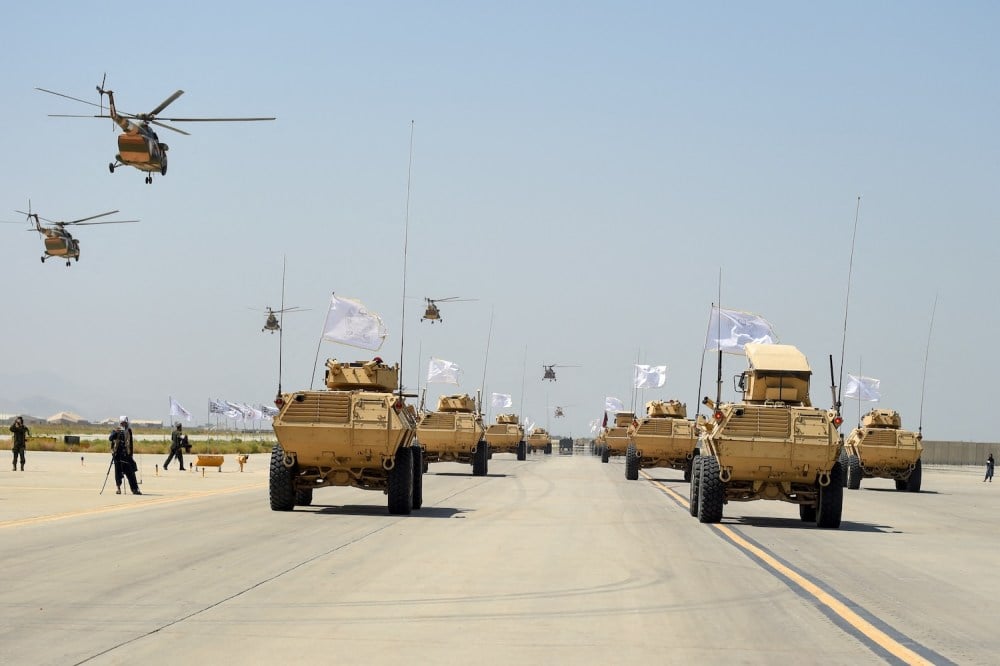It’s not every day that a U.S. president publicly demands the return of a military base from a former adversary. But that’s exactly what happened last week, when President Donald Trump said that his administration is “trying to get” Bagram back from the Taliban.
The statement sparked a mix of surprise and skepticism. Once the nerve center of U.S. military operations in Afghanistan, the Bagram Airfield was abandoned during the messy 2021 U.S. withdrawal and quickly taken over by the Taliban. Now, four years later, it has resurfaced as Trump’s latest foreign-policy gambit, rekindling debate over the United States’ unfinished business in the Taliban-controlled Afghanistan.
Trump, who has repeatedly raised the issue of control of Bagram since the withdrawal, now appears to be ramping up his push. “We want it back and we want it back soon. Right away,” he warned on Sept. 20.
Media reports indicate that the White House is actively weighing options to reestablish a U.S. foothold at the base, citing both its counterterrorism value and its proximity to key Chinese nuclear facilities. Located 40 miles north of Kabul, the base remains fully capable of supporting large aircraft, drones and surveillance platforms, special operations forces, and rapid-response missions. Where its loss came to symbolize American retreat, regaining Bagram could mark a bold reassertion of U.S. power in a turbulent region.
While the Taliban quickly rejected Trump’s idea, the issue is far from settled. In recent years, internal fissures within the group have widened, driven by growing discontent over the emir’s consolidation of power and his merging of clerical authority with executive control over policy and personnel decisions.
Combined with mounting economic desperation and the escalating threat from the Islamic State-Khorasan (IS-K), fractures are reshaping the Taliban’s internal dynamics and creating potential openings for practical engagement. Given the regime’s obsession with survival and pressure from within its own ranks, Trump’s idea is not as far-fetched as it may seem. His team could exploit these cracks through a right mix of incentives, back-channel diplomacy, and pressure from regional actors. Both symbolically and operationally, Bagram remains one of the few fixed assets capable of reinserting U.S. influence across the South Asia and Central Asia regions.
“If Afghanistan doesn’t give Bagram Airbase back to those that built it, the United States of America, BAD THINGS ARE GOING TO HAPPEN!!!” Trump wrote in a Sept. 20 Truth Social post. That blunt threat signals a possible recalibration of U.S. posture in a region where U.S. influence has sharply declined. Since the withdrawal, IS-K has rapidly expanded operations, terrorist safe havens have resurfaced, and U.S. intelligence collection has weakened considerably. Meanwhile, China, Russia, and Iran have moved aggressively to fill the vacuum.
The case for returning to Bagram is driven by urgent security requirements. U.S. government assessments warn that IS-K could rebuild its external operations capabilities within months if left unchecked. With no physical U.S. presence in Afghanistan, the current over-the-horizon model, which relies on distant bases in the Gulf, is a poor substitute for the proximity and on-the-ground visibility needed for effective counterterrorism.
The administration now faces several potential pathways, each fraught with risks and trade-offs. The real challenge lies in structuring an arrangement that delivers meaningful value without inviting mission creep or open-ended commitments. Trump’s penchant for transactional diplomacy could give him a unique advantage in striking such a deal.
The most direct route forward would be a negotiated agreement with the Taliban, either as a stand-alone deal or an expansion of the existing U.S.-Taliban Doha framework. In exchange for partial or full access to Bagram, Washington could offer what amounts to a survival package that includes economic assistance, counterterrorism cooperation, and gradual steps toward political normalization and easing sanctions. The Taliban would almost certainly demand international legitimacy, starting with a seat at the United Nations, as well as relief from financial and travel restrictions. A more distant but significant opportunity lies in potential U.S. investment in a lithium mine in Afghanistan. If included in the broader deal, it could deliver substantial benefits for both sides and plug Afghanistan into global supply chains.
While hard-liners, especially the emir in Kandahar, are expected to resist any accommodation with Washington, other factions within the Taliban’s uneasy coalition may privately favor such a deal as both tolerable and profitable. The emir, however, is neither untouchable nor invincible, particularly if he refuses to compromise and faces dissent from within his own ranks. Although direct dialogue with the emir remains largely untested, the regime’s broader reality as an isolated, cash-strapped hermit state increasingly vulnerable to IS-K offers meaningful leverage. These conditions may make a negotiated opening more plausible than it might appear.
A more politically acceptable alternative could involve a third-party arrangement, potentially outsourcing Bagram’s management to a Gulf intermediary such as Qatar or the United Arab Emirates, a NATO member such as Turkey, or even a Central Asian partner such as Uzbekistan. These countries maintain close ties with the Taliban, have accepted regime-appointed ambassadors, and remain close security partners of Washington.
Under such an arrangement, Bagram could be repurposed as a joint counterterrorism hub and training facility, technically overseen by an external partner but functionally enabling U.S. access for intelligence collection, surveillance, and operations.
Qatar, for instance, already hosts a U.S. interests section within its embassy in Afghanistan and facilitates back-channel talks with the Taliban. Uzbekistan, which shares a border with Afghanistan, still houses dozens of U.S.-supplied combat helicopters and other military equipment previously provided to the former Afghan government, assets that the Taliban are eager to recover. But more importantly, Uzbekistan faces serious threats from at least four Uzbek jihadi groups, all of which enjoy Taliban sanctuary and maintain operational ties with al Qaeda, IIS-K, and Hayat Tahrir al-Sham in Syria. These concerns have pushed Uzbekistan to seek a closer counterterrorism partnership with Washington.
Meanwhile, the United Arab Emirates manages four of Afghanistan’s main airports, including Kabul International Airport. It oversees systems and technology, terminal operations, and ground services, giving it considerable visibility into Taliban logistics and movement. This role, combined with the UAE’s deepening technological footprint in Afghanistan’s telecommunications and energy sectors, further enhances its insight into the regime’s internal workings. The UAE has also hosted Taliban dissenters and enjoys high-level, direct access to senior Taliban leadership, including during sensitive engagements such as hostage negotiations.
Such a third-party arrangement could provide Washington both legal and diplomatic cover while minimizing the optics of direct engagement with the Taliban. For the Taliban, it could provide a face-saving narrative by allowing them to present the partnership as engagement with a fellow Muslim nation rather than with the United States itself. While they may demand some visibility into U.S. activities at the base or seek to limit certain operations, especially those targeting al Qaeda, a workable compromise could still preserve the United States’ core counterterrorism capabilities on the ground.
A third option could draw on the post-9/11 precedent with Pakistan, where the United States operated for years from airfields in Jacobabad and Pasni under the nominal control of the Pakistani government. That arrangement showed how even adversarial or uneasy partners can collaborate when the right incentives or threats are on the table. A similar low-visibility setup at Bagram could enable U.S. personnel to operate discreetly in designated zones, possibly with Taliban-appointed liaisons serving as intermediaries. Though politically delicate, such quiet engagement would mirror existing forms of U.S.-Taliban interaction, ranging from back-channel coordination on migration and humanitarian aid to limited dialogues on counterterrorism and narcotics issues, including the sharing of actionable targeting information. If the Taliban were to refuse such an arrangement, Pakistan could once again emerge as a fallback partner by providing U.S. access to facilities within its own territory.
Another alternative could involve a hybrid civilian-military consortium, a joint venture between select Gulf, Taliban, and U.S. stakeholders. In this version, Bagram could be rebranded as a civilian logistics, maintenance, and aviation hub with embedded security and intelligence components managed by American personnel. While unconventional, similar gray-zone basing arrangements have proven effective in places such as Somalia, Iraq, Djibouti, and the Sahel.
If formal channels fail, the United States could opt for a covert presence by leveraging intelligence networks, paramilitary units, or private contractors. This approach could build on existing relationships with former Afghan strike units, regional intermediaries, or even Taliban defectors. It could resemble the CIA-run Counterterrorism Pursuit Teams, who were recruited in the early days of the Afghan campaign and remained active in Afghanistan until the Taliban takeover. Many of the units’ members have since been resettled in the United States and partner countries.
While the risks of exposure and Taliban retaliation would be significant, this approach is consistent with the U.S. track record of operating in hostile environments through deniable means. However, such efforts could face serious challenges, including the growing threat of Taliban hostage-taking involving U.S. dual nationals, a recurring issue that has already entangled Washington in ransom-driven hostage diplomacy with the regime.
Beyond counterterrorism, the big-picture rationale for the United States wanting Bagram back is just as compelling. China is rapidly deepening its footprint in Afghanistan, pursuing rare-earth minerals and embedding itself in critical infrastructure. Russia, having moved early to formally recognize the Taliban government, is expanding its security engagement. Iran continues to move weapons, fighters, and currency across Afghan borders with little resistance. India, though sidelined, is watching with concern. And Pakistan—long a disruptive player in Afghan affairs—is readjusting its position amid rising instability inside Pakistan and growing tensions with the Taliban over cross-border sanctuaries involving the Pakistani Taliban.
To be sure, any U.S. return to Bagram would be seen by China and Russia as a direct challenge to their regional influence, likely prompting them to pressure the Taliban to resist such a move. Iran would oppose any U.S. reentry outright. Pakistan would be forced to balance its ties with the Taliban and its dependency on China to reap potential gains from renewed cooperation with Washington. India, though unlikely to say so publicly, would quietly welcome it. Ultimately, the Taliban understand that no country can, nor would, outmatch the scale of U.S. investment or rival its influence.
In the end, getting Bagram back won’t be easy. But if the Trump administration embraces a pragmatic bargain and explores creative basing arrangements, it could secure a meaningful foothold without slipping into another costly entanglement. In a region where the United States’ absence has created a dangerous vacuum—and where the Taliban have now held power for the full length of a U.S. presidential term—reestablishing access to Bagram under new terms and for new priorities could represent a significant foreign-policy win for the administration. It’s an opportunity worth seizing.
The post How Trump Could Get Bagram Back appeared first on Foreign Policy.




